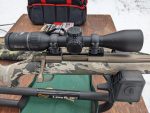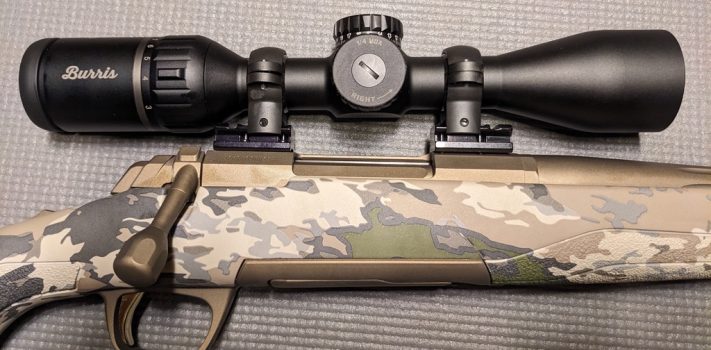In January, I tested Burris’ Signature HD 2-10x40mm rifle scope. It offers a versatile optic with a decent sight picture in an attractive package.
The Ballistic Plex E3 reticle that I tested provides hashmarks on the vertical crosshair calibrated to the ballistic performance of common hunting cartridges, and dots on the horizontal crosshair to compensate for crosswinds in 10 mph increments. Scopes in the Signature HD series are also available with Plex, Fine Plex, and 6.5 Creedmoor reticles.
I had some initial problems in my testing due to an error on my part (I did not tighten the rings sufficiently), but experienced good results after correcting my error.
With an enviable “Forever Warranty” (“No Charge. No warranty card needed. No receipt needed. No questions asked.”), and a manufacturer-suggested retail price of $455, the Signature HD scope may be a good option for deer hunting or similar applications.
The Backstory
I recently received a press release about Burris’ Signature HD2-10X40mm rifle scope. It looked interesting, so I asked Burris if I could borrow a unit for testing and evaluation. They were kind enough to agree. They also offered to provide a set of rings. About a week later the much-anticipated package arrived via UPS.
Opening the Box
The shipping box contained a clamshell package with the rings and a package box with the scope. The package box contained the scope seated in a foam cutout, a tag with information about the “Forever Warranty” described above, and a plastic sleeve. The plastic sleeve contained a cleaning cloth, a general rifle scope user guide, and a more specialized user guide for the Signature HD series.
I was distressed to notice a sticker on the scope indicating that it is made in China. When I asked to borrow the scope, I believed that Burris products were made in the USA and the Philippines using some Japanese parts. I don’t usually review products manufactured in mainland China. Since Burris loaned me the scope in good faith, I felt that I should honor that good faith by following through a review of the scope.
I like the package box. It seems well designed to protect the scope without diverting unnecessary resources from the product to the packaging.
The general user guide contains six pages of instructions each in English, Italian, German, Spanish, French, Swedish and what I believe to be Russian (my ability to discern between various languages using the Cyrillic alphabet is a bit shaky at best).
The locking screws on the windage and elevation turrets can be loosened and tightened with a coin. I thought that I might like this feature, but found that I did not like it in actual practice. I didn’t happen to have any coins with me at the range, and the coin-shaped slots in the heads of the locking screws did not adapt well to the screwdriver on my Victorinox Swiss Army Class SD knife or any other tools that I had with me at the range. As a result of this and similar experiences, my first preference for windage and elevation adjustment would be turrets that can be adjusted without the use of tools. My next preference would be turrets that can be adjusted with the help of a small flat-headed screwdriver.
The nitrogen-filled tube-chassis is waterproof and fogproof. This was borne out in my testing, when some fairly significant inclement weather did not result in any loss of visibility through the scope.
The scope has a rear focal plane reticle, so the holdover hashmarks on the vertical crosshair are only accurate at the highest (10X) magnification setting.
Installation
My test platform was a Browning X-Bolt Speed in 6.5 Creedmore. I began by installing Browning Weaver-Style scope bases on the rifle using the T15 tool on a folding Torx wrench set.
 Next, I installed medium Burris 1″ Weaver-Style Signature Zee Rings on the bases using the T15 tool that was supplied with the rings. Although I already had a Torx wrench set, I felt that supplying a tool with the rings was a nice touch. I did not feel that the bases and rings left much room for sliding the scope forward or backward in order to adjust the eye relief. But when I mounted the scope in the rings, I found that it fell exactly into the right place, so that the eye relief did not need any adjustment.
Next, I installed medium Burris 1″ Weaver-Style Signature Zee Rings on the bases using the T15 tool that was supplied with the rings. Although I already had a Torx wrench set, I felt that supplying a tool with the rings was a nice touch. I did not feel that the bases and rings left much room for sliding the scope forward or backward in order to adjust the eye relief. But when I mounted the scope in the rings, I found that it fell exactly into the right place, so that the eye relief did not need any adjustment.
I then leveled the scope and focused the reticle. I believed that I tightened the rings adequately at this point, but I was apparently too cautious in the amount of torque that I applied.
The First Range Session
I put on insulated canvas coveralls and a jeep cap, took the rifle and some ammo, and headed for the improvised range behind my pole barn.
It was a grey day in late January, with a temperature of about 30 degree Fahrenheit. Wind was minimal. There was no precipitation when I began the range session. Eventually a light snow began to fall, which gradually increased in intensity over the course of the range session.
I set up some targets by the backstop, and then in harmony with the instructions in the user manuals, set up a shooting table 25 yards away for the preliminary adjustments.
I placed the rifle in a lead sled, removed the bolt, and bore-sighted the scope. Then I fired a single round of Sellior & Bellot 140 grain SP, which hit about 2 inches low and about 1.5 inches to the right of the point of aim.
I found the wider viewing angle offered by the 2X magnification to very pleasant at this shorter range in comparison with the 3X magnification offered by many similar scopes.
 I struggled over the course of the next six shots attempting to zero the scope. The point of impact seemed to drift farther and farther away from the point of aim regardless of how I adjusted the scope. Finally, the scope seemed to settle down and started responding appropriately to adjustment attempts. I was able to dial in the windage satisfactorily, but even with maximum adjustment to the elevation, the point of impact remained about 1.5 inches lower than the point of aim.
I struggled over the course of the next six shots attempting to zero the scope. The point of impact seemed to drift farther and farther away from the point of aim regardless of how I adjusted the scope. Finally, the scope seemed to settle down and started responding appropriately to adjustment attempts. I was able to dial in the windage satisfactorily, but even with maximum adjustment to the elevation, the point of impact remained about 1.5 inches lower than the point of aim.
I subsequently discovered that the rings were slightly too loose, so that recoil gradually drove the scope farther and farther forward in the rings. Once the scope was driven all the way forward into the rings, the zero remained consistent.
I fired a number of three shot groups with several different types of ammo. I found that the rifle was not very accurate with Aguila 140 grain FMJBT ammo. The rifle/scope combination did produce acceptable groups with the other two types of ammunition that I was using (Sellier & Bellot 140 grain SP and Winchester 129 grain Power Point).
Snow began to accumulate on my pad of paper, making note-taking increasingly difficult. A significant amount of snow accumulated and melted on the scope and rifle as well. The melting snow did not penetrate the scope tube, cause fogging, or interfere with the operation of the scope in any way.
Following the range session, I wiped the excess moisture off the scope with a rag. No further care of the scope was necessary. The rifle received a more extensive cleaning.
The Second Range Session
For the second range session, I utilized the 100-yard indoor range at the local rod and gun club. The rifle/scope combination produced decent groups, ranging from 1.075 to 1.45 MOA using the Sellier & Bellot and Winchester ammos. These are very good groups for me, since I am not the greatest bench rest shooter in the world. The sight picture produced by the scope at 10X magnification at 100 yards was not as crisp and clear as I could have wished. This scope can definitely put a shot where it counts at 100 yards, but there is a hint of fuzziness, distortion and even color shift in the sight picture.
The Burris Company
Burris Optics is an American optics company headquartered in Greenley, Colorado. It was founded in 1971 by Don Burris, who was formerly a design engineer with Redfield Gun Sight Company. Burris products include rifle scopes, range-finding equipment, thermal optics, binoculars, handgun scopes, spotting scopes, rings, mounts, and accessories.
Conclusions
I found the Burris Signature HD 2-10x40mm rifle scope to work effectively when used properly. I enjoyed the wide field of view at 2X magnification, and the reliable function under inclement weather conditions. I was impressed with Burris’ “Forever Warranty”, and the hashmarks and dots of the Ballistic Plex E3 reticle seem well designed for practical field use.
I did not particularly like the coin slots on the locking caps of the windage and elevation turrets. The sight picture at 10X magnification at 100 yards could have been more crisp and clear. I was disappointed to discover that the scope is manufactured in China.
All in all, the scope has many attractive features and should serve the user well in daily use.
Disclaimer
Burris was kind enough to loan me their Signature HD 2-10X40mm scope and 1″ Signature Medium Zee Rings for testing and evaluation. I tried not to let their kindness influence my objectivity, and believe that I have succeeded. I did not receive any other financial or other inducement to mention any vendor, product, or service in this article.










